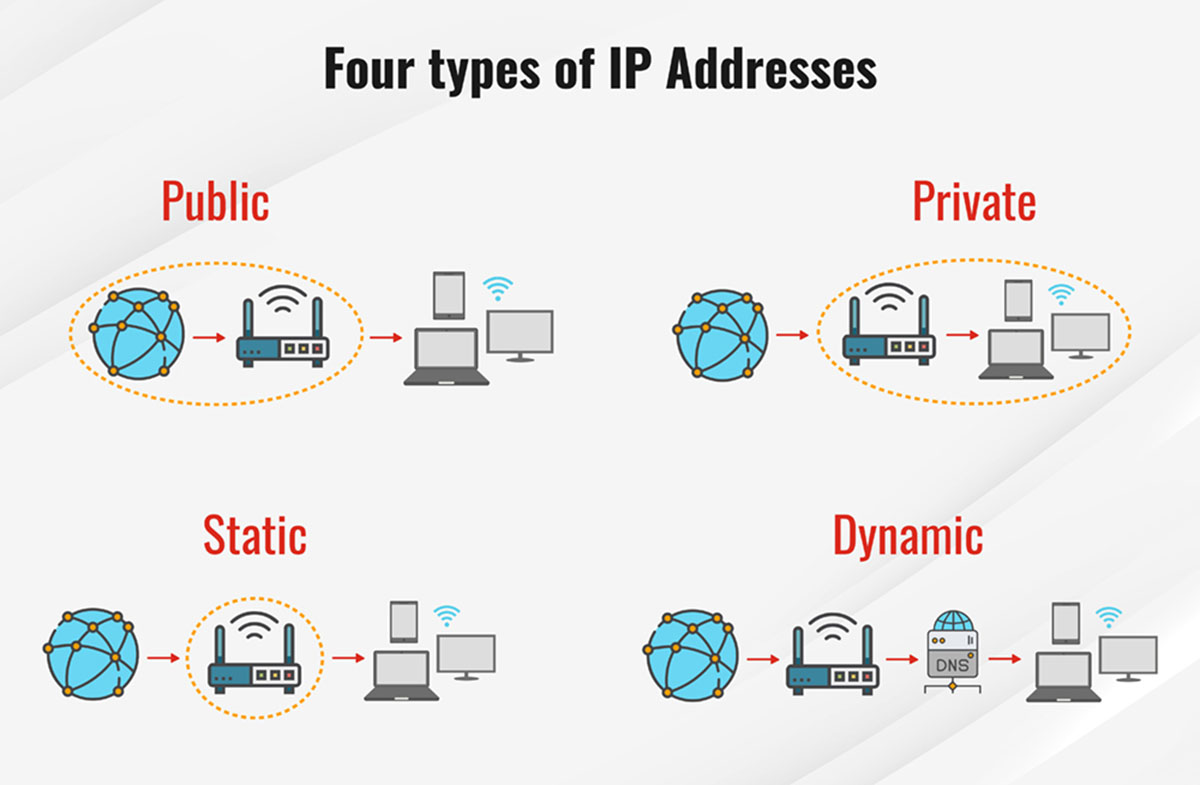Introduction
An IP address is a fundamental component of the modern internet. It acts as a unique identifier for devices connected to a network, allowing them to communicate and exchange data. Whether you realize it or not, you encounter IP addresses every time you go online, whether it’s browsing the web, sending emails, or streaming videos.
But what exactly is an IP address? In simple terms, it is a numerical label assigned to each device on a network. This label helps routers and other networking devices identify where data should be sent and received. Without IP addresses, the internet as we know it would not exist.
The assignment of IP addresses is a complex process. Internet Service Providers (ISPs) are responsible for allocating addresses to their customers, using various techniques such as Dynamic Host Configuration Protocol (DHCP) or static assignment. The Internet Protocol version 4 (IPv4) is the most widely used today, but the transition to IPv6 is well underway to accommodate the increasing number of devices connected to the internet.
An IP address consists of four sets of numbers separated by periods. Each set, known as an octet, can range from 0 to 255. This format, known as dotted-decimal notation, allows for billions of unique combinations, ensuring that devices on different networks can be uniquely identified.
IP addresses can be categorized as public or private. Public IP addresses are assigned by ISPs and are unique to each device on the internet. They allow devices to be accessed from anywhere in the world. On the other hand, private IP addresses are used within local networks, such as home or office networks, and are not accessible from the internet directly.
IP addresses can also be either dynamic or static. Dynamic IP addresses are temporary assignments that change over time and are commonly used for consumer internet connections. In contrast, static IP addresses are permanent and provide a fixed address for devices that require consistent access, such as web servers or surveillance systems.
In the next sections, we will explore how IP addresses are used in network communication, the role of DNS (Domain Name System) in translating domain names to IP addresses, the importance of IP address security, and more. Understanding how IP addresses work will give you a deeper appreciation for the complex ecosystem that powers the internet and plays a crucial role in our daily lives.
Definition of an IP address
An IP address, short for Internet Protocol address, is a unique numerical label assigned to each device connected to a computer network. It serves as a means of identification, allowing devices to send and receive data within the network and across the internet.
The format of an IP address typically consists of four sets of numbers separated by periods, such as 192.168.0.1. Each set, called an octet, can range from 0 to 255. This numbering system, known as dotted-decimal notation, provides over four billion possible combinations, ensuring that each device connected to a network has a distinct IP address.
IP addresses are part of the underlying infrastructure of the internet, enabling devices to locate and communicate with each other. Just like a home address allows mail to be delivered to the correct recipient, an IP address allows data packets to be exchanged between devices.
IP addresses can be classified into two main categories: IPv4 and IPv6. IPv4, which stands for Internet Protocol version 4, is still widely in use today. It consists of a 32-bit address, divided into four octets. However, due to the growing number of devices connecting to the internet, the transition to IPv6 has become necessary.
IPv6, or Internet Protocol version 6, offers a significantly larger address space compared to IPv4. It uses a 128-bit address, allowing for an almost unlimited number of unique IP addresses. This addresses the scarcity of IPv4 addresses and supports the continued growth of internet-connected devices.
IP addresses play a crucial role in network communication. They provide the necessary information for packets of data to be routed from their source to their destination. By including source and destination IP addresses in the packet headers, routers can determine the most efficient path for the data to travel across the network.
Understanding the concept of IP addresses is essential for various technical fields, such as networking, web development, and cybersecurity. It enables professionals to configure networks, troubleshoot connectivity issues, secure network infrastructure, and much more.
In the following sections, we will explore how IP addresses are assigned, the differences between public and private IP addresses, dynamic and static IP addresses, and their role in network communication. A deeper understanding of IP addresses will shed light on the complexities of the internet and its underlying infrastructure.
How IP Addresses are Assigned
The assignment of IP addresses is a crucial process that ensures that each device connected to a network has a unique identifier. Typically, Internet Service Providers (ISPs) are responsible for assigning IP addresses to their customers. There are different methods and protocols used for IP address assignment, depending on the type of network and the requirements of the devices connected to it.
One common method used for IP address assignment is the Dynamic Host Configuration Protocol (DHCP). DHCP allows devices to request and obtain an IP address automatically from a DHCP server. When a device connects to a network, it sends a request to the DHCP server, which then assigns an available IP address from a predetermined pool. The assigned IP address is temporary and will be released back to the pool after a certain period of inactivity or when the device disconnects from the network. This method is widely used for home networks or small businesses, where IP addresses need to be allocated dynamically to a large number of devices.
Static IP address assignment is another method commonly used, particularly for devices that require consistent access and permanent identification, such as servers or network devices. In this case, network administrators manually assign specific IP addresses to these devices. The assigned IP addresses remain fixed and do not change over time. Static IP addresses are beneficial for devices that provide specific services, as they maintain a consistent address that can be easily accessed by other devices on the network or the internet.
When it comes to IP address versions, Internet Protocol version 4 (IPv4) is currently the most widely used. IPv4 addresses consist of 32 bits, divided into four octets. However, the rapid expansion of the internet and the increasing number of connected devices have led to an exhaustion of available IPv4 addresses. To address this issue, a newer IP address version called Internet Protocol version 6 (IPv6) was introduced.
IPv6 uses a 128-bit address space, allowing for an almost infinite number of unique IP addresses. Unlike IPv4, which uses dotted-decimal notation, IPv6 addresses are expressed in hexadecimal format and separated by colons, such as 2001:0db8:85a3:0000:0000:8a2e:0370:7334. The adoption of IPv6 is gradually increasing to accommodate the growing demand for IP addresses and ensure the sustainability of the internet in the future.
IP address assignment is a fundamental step in establishing network connectivity. Whether through DHCP for dynamic assignment or manual assignment of static IP addresses, ISPs and network administrators play a crucial role in ensuring that devices are allocated unique and appropriate addresses. Understanding the different methods and versions of IP address assignment is key to effectively managing network resources and maintaining seamless communication between devices.
IPv4 vs IPv6
Internet Protocol version 4 (IPv4) and Internet Protocol version 6 (IPv6) are two different versions of the IP address system. While IPv4 has been widely used for several decades, the rapid growth of the internet and the need for more unique addresses has led to the development and adoption of IPv6.
IPv4 addresses are 32-bit numbers that are expressed in dotted-decimal notation, such as 192.168.0.1. This format allows for approximately 4.3 billion unique addresses. However, as the internet expanded and the number of connected devices increased exponentially, IPv4 addresses began to run out. Additionally, the allocation of IPv4 addresses is not optimally designed, resulting in a fragmented address space.
IPv6 addresses, on the other hand, are 128-bit numbers expressed in hexadecimal format, separated by colons, such as 2001:0db8:85a3:0000:0000:8a2e:0370:7334. With 128 bits, IPv6 allows for an astronomically large number of unique addresses, approximately 340 undecillion (3.4 x 10^38).
The adoption of IPv6 is essential for the continued growth of the internet and the increasing number of devices connecting to it. With the vast address space provided by IPv6, every device can have a unique and permanent IP address, eliminating the need for techniques like Network Address Translation (NAT) used in IPv4 to conserve addresses. Additionally, IPv6 offers other benefits, such as improved efficiency, better security, and support for new features and protocols.
Despite the advantages of IPv6, the transition from IPv4 to IPv6 is a gradual and complex process. Not all devices and networks are IPv6-compatible, and the internet infrastructure needs to be updated to support and prioritize IPv6 traffic. However, many ISPs, network equipment manufacturers, and organizations are actively working towards the deployment and adoption of IPv6 to ensure the continued growth and connectivity of the internet.
In the current state, IPv4 and IPv6 coexist and can communicate with each other through various mechanisms like dual-stack, tunneling, or translation techniques. This transitional period allows for the gradual implementation of IPv6 without disrupting existing IPv4 networks.
Understanding the difference between IPv4 and IPv6 is crucial in today’s interconnected world. Network administrators, ISPs, and developers need to be aware of the limitations of IPv4 addresses, the benefits of IPv6, and the steps involved in the migration process. As more devices become IPv6 compatible, the transition to IPv6 will become increasingly important to ensure the continued growth and reliability of the internet.
Components of an IP Address
An IP address consists of specific components that define its structure and functionality. Understanding these components is essential for working with and managing IP addresses effectively.
1. Version: The IP address version indicates whether it is an IPv4 or IPv6 address. IPv4 addresses are comprised of 32 bits, while IPv6 addresses are composed of 128 bits.
2. Network Prefix: The network prefix, also known as the network portion or network ID, identifies the network to which the IP address belongs. It specifies the portion of the IP address that is common to all devices within the same network.
3. Host Identifier: The host identifier, also known as the host portion or interface ID, identifies the specific device or host within a network. It distinguishes it from other devices on the same network.
4. Subnet Mask: The subnet mask is used in conjunction with the IP address to determine the network and host portions. It determines the size of the network and the number of available host addresses within that network.
5. Default Gateway: The default gateway is the IP address of the device that acts as the exit point for traffic leaving a network to communicate with devices on other networks. It is essential for routing packets outside the local network.
6. Broadcast Address: The broadcast address represents all devices within a network. When a packet is sent to the broadcast address, it is received by all devices within that network.
7. Class: In IPv4, the first octet of the IP address is used to determine the class of the address. Classes A, B, and C are used for different sizes of networks, while classes D and E are reserved for special purposes.
Each component plays a significant role in defining the purpose and functionality of an IP address. They help route packets to the correct network, identify specific devices within a network, determine the size of the network, and facilitate communication between networks.
When working with IP addresses, it is important to understand how these components work together and how they can be manipulated or configured to meet specific network requirements. Proper management and configuration of IP addresses ensure efficient network communication and facilitate the secure and reliable transfer of data worldwide.
Public vs Private IP Addresses
IP addresses can be classified as either public or private, based on their accessibility and usage. Understanding the difference between public and private IP addresses is essential for network administrators and users alike.
Public IP addresses are globally unique and assigned by Internet Service Providers (ISPs). These addresses are used to identify devices on the internet and are accessible from anywhere in the world. Public IP addresses allow devices to establish direct communication with other devices on different networks, allowing services such as web browsing, email, and online gaming to function properly.
Public IP addresses play a crucial role in internet communication as they allow devices to send and receive data packets across the internet. They are obtained from a pool of addresses maintained by the Internet Assigned Numbers Authority (IANA) and allocated to ISPs, who then assign them to their customers.
Private IP addresses, on the other hand, are used within local networks, such as home or office networks. These addresses are not directly accessible from the internet and are reserved for private use. Private IP addresses are used to identify devices within a network and allow them to communicate internally without being exposed to the external internet.
The use of private IP addresses helps conserve public IP address space, as multiple devices can share a single public IP address when accessing the internet through a router or network gateway. Private IP addresses are defined in specific address ranges reserved for local networks and are not routable on the internet.
There are three classifications of private IP address ranges established by the Internet Engineering Task Force (IETF):
1. Class A: The range of Class A private addresses is 10.0.0.0 to 10.255.255.255, with a subnet mask of 255.0.0.0.
2. Class B: The range of Class B private addresses is 172.16.0.0 to 172.31.255.255, with a subnet mask of 255.240.0.0.
3. Class C: The range of Class C private addresses is 192.168.0.0 to 192.168.255.255, with a subnet mask of 255.255.0.0.
Private IP addresses provide security and network isolation within local networks as they are not directly exposed to the internet. However, devices with private IP addresses can still access the internet through Network Address Translation (NAT) techniques, where a router or network gateway translates private IP addresses into a single public IP address when communicating with the internet.
Understanding the distinction between public and private IP addresses is crucial for network administrators, as it allows them to configure network devices, manage internet connectivity, and ensure secure communication. By properly utilizing public and private IP addresses, organizations can create secure and efficient internal networks while maintaining internet connectivity for their devices.
Dynamic vs Static IP Addresses
IP addresses can be categorized as either dynamic or static, based on the method used for their assignment and how they are managed. Understanding the difference between dynamic and static IP addresses is crucial for network administrators when configuring devices on a network.
Dynamic IP addresses are automatically assigned to devices by a Dynamic Host Configuration Protocol (DHCP) server. When a device connects to a network, it sends a request for an IP address to the DHCP server. The server then assigns an available IP address from a pool of addresses specifically set aside for dynamic assignments. The assigned IP address is borrowed and can change over time.
The use of dynamic IP addresses is common in home networks or small businesses where there are a large number of devices connecting and disconnecting from the network frequently. Dynamic IP allocations are temporary and depend on the device’s presence on the network. When a device disconnects or the lease time expires, the IP address is released back to the pool for other devices to use.
Static IP addresses, on the other hand, are manually assigned to a device and remain constant over time. Network administrators manually configure the IP settings on the device to ensure it always receives the same IP address. Static IP addresses are often used for devices that require permanent identification, such as servers, printers, or network equipment.
The use of static IP addresses offers several advantages. It allows for easier device management, as administrators always know the fixed IP address assigned to a specific device. Static IP addresses are also beneficial for services that require consistent availability and accessibility, as they provide a predictable address for other devices to connect to.
Moreover, static IP addresses eliminate the need for devices to rely on DHCP servers during network initiation. This reduces the dependency on external servers and streamlines the device’s startup process, especially in cases where immediate network connectivity is critical.
However, managing static IP addresses can be more time-consuming and requires careful planning and documentation. Network administrators need to ensure that there are no IP address conflicts and that addresses are allocated efficiently to avoid wasting available IP space.
Both dynamic and static IP addresses have their uses in different network scenarios. Dynamic IP addresses are suitable for devices that frequently join and leave the network, requiring flexible IP assignments. Static IP addresses, on the other hand, are ideal for devices that necessitate consistent accessibility and identification.
Whether utilizing dynamic or static IP addresses, proper network management and administration are essential to maintain the integrity and performance of the network infrastructure.
How IP Addresses are Used in Network Communication
IP addresses play a critical role in network communication, enabling devices to send and receive data packets across networks. They serve as unique identifiers that allow routers and other networking devices to route data to the intended destination. Understanding how IP addresses are used in network communication is key to comprehending the fundamental functioning of the internet.
When data is transmitted over a network, it is divided into small units called packets. Each packet contains the source and destination IP addresses in the packet header. These IP addresses provide crucial information for routers to determine the appropriate path, or route, for the packet to follow through the network.
Devices, such as computers or smartphones, use their own IP addresses as the source IP address when sending packets. The source IP address allows the recipient device to know where the data originated from and enables it to send a response back.
Upon receiving a packet, routers examine the destination IP address in the packet header and compare it to their routing table. The routing table contains information about how to forward packets based on their destination IP addresses. Routers determine the next hop, or next router or network device, to send the packet to based on the routing table’s information and the networks they are connected to.
As the packets traverse the network, each router makes a forwarding decision based on the destination IP address, sending the packets closer to their intended destination. This process continues until the packets reach the destination device or network.
IP addresses are essential for the internet’s underlying routing protocols, such as Border Gateway Protocol (BGP) and Open Shortest Path First (OSPF). These protocols allow routers to dynamically exchange routing information, enabling efficient and reliable packet delivery across complex networks.
Without IP addresses, routers would not have the information necessary to direct packets to their intended destinations. The unique identification provided by IP addresses ensures that data is correctly routed and reaches the correct device or network.
Moreover, IP addresses enable devices and services to connect and communicate with one another. Whether it’s browsing the web, sending emails, video conferencing, or accessing cloud services, IP addresses are utilized at every step of network communication.
Overall, IP addresses are the backbone of network communication, allowing for the seamless exchange of data between devices and networks. They provide the necessary addressing information for routing packets, facilitating the flow of information across the internet and enabling the vast array of online services we rely on every day.
The Role of DNS in IP Addresses
DNS, short for Domain Name System, plays a crucial role in the translation of domain names into IP addresses. It acts as a distributed database that maps human-friendly domain names, like www.example.com, to their corresponding IP addresses, such as 192.0.2.1. Understanding the role of DNS in IP addresses is fundamental to navigating the internet and accessing websites and services.
When a user types a domain name in their web browser, such as www.example.com, the browser sends a request to a DNS resolver or DNS server to retrieve the corresponding IP address. The DNS resolver then initiates a series of DNS lookups to find the IP address associated with the domain name.
The DNS lookup process begins by checking the local cache of the DNS resolver. If the IP address for the domain name is found in the cache, the resolver can provide the answer immediately. This caching mechanism helps improve the efficiency of subsequent DNS lookups by reducing the need to query authoritative DNS servers.
If the IP address is not found in the local cache, the DNS resolver contacts the root nameservers. Root nameservers are the starting point for resolving domain names and have information about the top-level domains (TLDs), such as .com, .net, or .org.
The root nameservers provide the DNS resolver with information about the TLD nameservers responsible for the requested domain. The resolver then queries the TLD nameservers to obtain the IP address of the authoritative nameservers for the domain.
Once the authoritative nameservers are identified, the resolver queries them to retrieve the IP address for the requested domain name. The authoritative nameservers are responsible for storing and providing the IP address information associated with specific domain names.
After obtaining the IP address from the authoritative nameservers, the resolver stores it in its local cache for future use. It then returns the IP address to the user’s web browser, allowing the browser to establish a connection with the web server associated with the domain name.
The DNS system performs this lookup process behind the scenes, enabling users to access websites and services using domain names instead of remembering complex IP addresses. DNS ensures that users can easily navigate the internet and locate resources without needing to memorize or manually enter IP addresses.
In addition to translating domain names to IP addresses, DNS also supports other record types, such as email server (MX) records, text (TXT) records, and others. This versatility allows DNS to support various internet services and protocols, facilitating the efficient operation of the internet.
Overall, the DNS system plays a vital role in internet navigation and connectivity. By transforming human-readable domain names into IP addresses, it simplifies the process of accessing websites and services, making the internet more user-friendly and accessible to everyone.
The Importance of IP Address Security
IP address security is of paramount importance in today’s interconnected world. As IP addresses serve as unique identifiers for devices on a network, securing them is crucial to safeguarding the integrity and privacy of network communications. Understanding the importance of IP address security can help organizations and individuals protect their networks from unauthorized access and malicious activities.
One significant aspect of IP address security is preventing unauthorized access to devices and networks. By securing IP addresses, organizations can control and restrict who has permission to access and communicate with their network resources. Access control lists, firewalls, and other security measures can be implemented to limit access to authorized individuals or devices, preventing potential security breaches and unauthorized activities.
IP address security also plays a vital role in protecting against network-based attacks, such as distributed denial-of-service (DDoS) attacks. Attackers often target the IP addresses of specific devices or networks in an attempt to overwhelm them with a flood of incoming traffic, rendering them inaccessible. By implementing robust security measures, organizations can identify and block malicious IP addresses, preventing such attacks from disrupting their network infrastructure.
In addition to protecting against external threats, IP address security is essential for maintaining the privacy of internal network communications. By ensuring that IP addresses are not exposed or leaked to unauthorized parties, organizations can prevent potential attacks, such as IP spoofing or eavesdropping. Encrypting network traffic, using secure protocols, and constantly monitoring network activities can all contribute to enhancing IP address security and protecting sensitive data.
Securing IP addresses is particularly important for businesses that rely on online transactions and customer information. Compromised IP addresses could be used to launch targeted attacks on customer accounts or gain unauthorized access to sensitive data. By implementing stringent security measures, such as two-factor authentication, intrusion detection systems, and regular security audits, organizations can minimize the risk of IP address-related security incidents.
Furthermore, IP address security is crucial for maintaining compliance with regulatory requirements. Many industries, such as healthcare and finance, have strict security standards that organizations must adhere to. Properly securing IP addresses is often a prerequisite for meeting these standards and avoiding potential penalties or legal repercussions.
Overall, IP address security is essential for protecting network infrastructure, preventing unauthorized access, safeguarding sensitive data, and ensuring compliance with industry regulations. By implementing robust security measures and staying vigilant about emerging threats, organizations can maintain the privacy, integrity, and availability of their networks, preventing potentially devastating security incidents from occurring.
Conclusion
IP addresses are a foundational component of the modern internet. They serve as unique identifiers for devices connected to a network, enabling communication and data exchange across the internet. Understanding how IP addresses work and their various aspects is essential for network administrators, developers, and individuals navigating the online world.
In this article, we explored the definition of an IP address and the assignment methods used to allocate them. We delved into the differences between IPv4 and IPv6, highlighting the importance of the transition from IPv4 to IPv6 due to the growing number of devices connecting to the internet.
We discussed the components that make up an IP address and the distinctions between public and private IP addresses. Understanding the roles of dynamic and static IP addresses is crucial for network configuration and device management.
We explored how IP addresses are used in network communication, facilitating the routing of data packets and enabling seamless communication across networks. DNS, the translation system for domain names to IP addresses, was discussed, emphasizing its crucial role in internet navigation.
Lastly, the importance of IP address security was highlighted, emphasizing the need for protecting IP addresses from unauthorized access, network-based attacks, and ensuring privacy and compliance with regulatory requirements.
With this comprehensive understanding of IP addresses, their assignment, usage, and security considerations, individuals and organizations can navigate the internet more effectively, configure networks efficiently, and protect their network infrastructure from potential threats.
As advancements in technology continue to shape our interconnected world, IP addresses will remain a fundamental backbone of communication and the internet. Continued awareness and vigilance in managing and securing IP addresses will play a crucial role in maintaining the integrity, availability, and privacy of network communications.

























